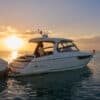Boat lifts are an accessory that many families feel is a necessity. There are many benefits to owning a boat lift which is why many opt to purchase one for their boat. Understanding the importance of a boat lift and what factors go into determining which is right for you is a great place to start. Factors include the type of boat you have, the type of boat lift you want or need, location, water depth, and your budget. These will all play a role in determining which lift is right.
Keep reading to learn everything about boat lifts. From the importance to the different types, this is your information hotspot for boat lifts.
Perks of Boat Lifts
Boat lifts have several benefits that make boat life even better than it already is. Not only does it make boating more convenient, but it also helps to maintain the quality of the boat. Boat lifts can help to provide protection from detrimental effects of the water.
Maintains Quality of Boat
Boat lifts that feature a cover can help to keep your boat dry and clean from any weather and dust or pollen that may dirty your boat. This added feature to a boat lift adds to the convenience as well. This keeps you from having to cover your boat every time you’re done on the boat.
Convenience
Storing your boat out of the water daily will help to keep the hull or toons in great shape for years. Keeping your boat tied up to a pier or sea wall will leave it susceptible to oxidation, electrolysis, and algae growth. These processes can lead to the deterioration of the toons or hull of your boat and ultimately decrease the efficiency of your boat.
Your Boat
Before we can dive into boat lifts, it’s important to understand that while the type of boat lift can be the same, it must be specific for your boat. For example, you cannot put a V-hull boat on a pontoon boat lift. That would be very problematic as it would likely cause costly damage.
This is especially important in today’s day in age because boats are vastly diverse. The hull of a MasterCraft is much different than the hull of a Cobalt. And, even more specifically, within brands, different models have many different hulls.
Along with the shape and design of the hull, the weight and length of the boat are important to acknowledge. If you put a heavy boat on a lift meant for a lighter boat, you risk breaking the lift and damaging the boat. A good rule of thumb when purchasing a boat lift is to buy a lift that is certified for a weight that is greater than that of your boat.
This is why it is important to get a lift specifically for your exact boat. It eliminates the possibility of many bad situations. In the end, ensuring the lift is right for your boat, you can protect it and reduce the chances of avoidable damage.
Type of Lift
There are several different types of boat lifts you can choose from. We will cover the top five lifts that most people use throughout the nation. All have their pros and cons so deciding which is right for you depends on what is most important to you and your family.
4-Post Conventional Lift
First, we’ll discuss the 4-post conventional boat lift. These lifts are extremely durable which makes them perfect for those living in areas with rough weather. Along with weather, these lifts can stand strong against strong waves and currents.
These lifts stand-alone meaning that they do not rely on a pier or a sea wall to keep them in place. They are great for heavier boats. If needed, these boat lifts can be built with 6-8 posts rather than 4 to support even heavier boats.
These are large lifts in the water and take up a good amount of space. If you don’t have much area to place a lift, this may not be the best option.
Elevator Lift
The next lift we want to examine is the elevator lift. These lifts were designed to utilize as little waterfront as possible. They can be mounted right on a sea wall or pilings allowing them to be used in shallow water.
These lifts have found their purpose with boat owners who live on narrow channels or canals. Elevator lifts allow boaters to lift their boat out of the water without needing a long pier and a ton of waterfront.
If you find yourself on a waterfront property with very little waterfront area, an elevator lift will be a great option for you and your family. Before deciding on this lift, be sure to understand the weight limit of the lift and the overall weight of your boat. This will lead you to purchasing the right lift for your boat.
Hydraulic Lift
Arguably the most popular boat lift you’ll find in front of many houses on lakes and rivers are hydraulic lifts. These are innovative lifts that have become very popular in recent years. The reason these lifts have gained popularity in recent years is because of their fast-lifting speeds and energy efficiency.
Hydraulic lifts feature steel tubes and pistons that power the boat up and down on the lift. Some lifts are hybrids with cables and hydraulic technology. Others are built with no cables. A great benefit of these lifts is that they can lift the boat high out of the water.
Some cons of a hydraulic boat lift are that they are not quite as sturdy as other lifts. They stand alone without any pilings drilled into the ground. This is why they work great for inland lakes and rivers. If you’re somewhere that experiences strong currents or weather, these lifts will likely not be strong enough to protect your boat.
Floating Lift
This unique innovation of a lift utilizes large tanks that inflate and deflate with air to raise a boat out of the water and lower it into the water. These lifts are great for deep water marinas or somewhere that can’t have a normal lift for one reason or another.
Some deep-water marinas allow floating lifts in their slips so boat owners can protect their boats by getting them out of the water. The disadvantage of a floating lift is that they are not completely stationary so strong currents or weather can cause big problems with these lifts.
Cantilever Lift
When you think of a boat lift, this is likely what your mind goes to first. These are very common boat lifts that are built with cables and a crank wheel. Cantilever lifts are simple set ups that are easy to maintain, especially for smaller boats.
These lifts are typically found in inland lakes and rivers. They can’t withstand strong weather and current because of their simple design. Cantilever lifts can’t get your boat very far out of the water because of how these are built. They are built to get the majority of the boat out of the water but occasionally, the stern still sits in the water.
Some cantilever lifts are built with the power to crank your boat up whereas others are hand-cranked. If your boat is on the heavier side, a hand crank lift might be very difficult and a hassle every time you need to raise your lift.
Price of a Boat Lift
The price of a boat lift is heavier dependent on several factors. First, the type of lift you choose. The price will vary for the technology that’s involved with the specific lift. The more technology and ease of use, the pricier the lift will be. Also, the sturdier the lift, the higher the price will be as well.
Another factor that will determine the price of a boat lift is the weight of your boat. If you have a super heavy, large boat, you can expect to pay more for a lift than someone with a jet ski.
For more information on the price of a lift for your boat, contact your local Action Water Sports. We will be able to point you in the right direction.
What Lift is Right for You?
After understanding the importance of a boat lift and learning about the different types, it’s time to decide which is right for you. A lot depends on where you’re planning on storing your boat. Is it in the Ocean or other rough water? Or, is it in an inland lake or slow-moving river?
These variables will narrow your choices down to determine which lift is right for you. If you’re unsure which boat lift would be the best fit for your situation, contact your local Action Water Sports.








